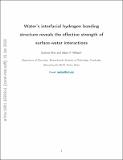Water’s Interfacial Hydrogen Bonding Structure Reveals the Effective Strength of Surface–Water Interactions
Author(s)
Shin, Sucheol; Willard, Adam P.
DownloadSubmitted version (2.060Mb)
Additional downloads
Publisher Policy
Publisher Policy
Article is made available in accordance with the publisher's policy and may be subject to US copyright law. Please refer to the publisher's site for terms of use.
Terms of use
Metadata
Show full item recordAbstract
The interactions of a hydrophilic surface with water can significantly influence the characteristics of the liquid water interface. In this manuscript, we explore this influence by studying the molecular structure of liquid water at a disordered surface with tunable surface-water interactions. We combine all-atom molecular dynamics simulations with a mean field model of interfacial hydrogen bonding to analyze the effect of surface-water interactions on the structural and energetic properties of the liquid water interface. We find that the molecular structure of water at a weakly interacting (i.e., hydrophobic) surface is resistant to change unless the strength of surface-water interactions is above a certain threshold. We find that below this threshold water's interfacial structure is homogeneous and insensitive to the details of the disordered surface, however, above this threshold water's interfacial structure is heterogeneous. Despite this heterogeneity, we demonstrate that the equilibrium distribution of molecular orientations can be used to quantify the energetic component of the surface-water interactions that contribute specifically to modifying the interfacial hydrogen bonding network. We identify this specific energetic component as a new measure of hydrophilicity, which we refer to as the intrinsic hydropathy.
Date issued
2018-06Department
Massachusetts Institute of Technology. Department of ChemistryJournal
The journal of physical chemistry. B
Publisher
American Chemical Society (ACS)
Citation
Shin, Sucheol and Adam P. Willard. “Water’s Interfacial Hydrogen Bonding Structure Reveals the Effective Strength of Surface–Water Interactions.” The journal of physical chemistry. B 122 (2018): 6781-6789 © 2018 The Author(s)
Version: Author's final manuscript
ISSN
1520-6106
1520-5207